Stapelia
Stapelia leendertziae N.E.Br.
Family:
Common names: bell stapelia, Leendertz’s carrion flower, carrion chalice, carrion flower, rugose cup starfish, maroon cup starfish, star flower, black bells (Eng.); aaskelk, aasklok, rooiaasblom, tulp assblom (Afr.)
Plant Attributes:
Plant Type:
SA Distribution:
Soil type:
Flowering season:
PH:
Flower colour:
Aspect:
Gardening skill:
Special Features:
Horticultural zones
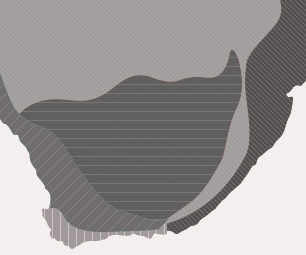
Stapelia gigantea N.E.Br.
Family:
Common names: giant stapelia, giant carrion flower, carrion flower (Eng.); reuseaasblom, aasblom, duikershoring, haasoor (Afr.); ililo elikhulu, isihlehle, uzililo (isiZulu); bohatsu (Sesotho); tililo (SiSwati); bandaulu (TshiVenda)
Plant Attributes:
Plant Type:
SA Distribution:
Soil type:
Flowering season:
PH:
Flower colour:
Aspect:
Gardening skill:
Special Features:
Horticultural zones

Stapelia L.
Family:
Common names: carrion flower (Eng.); aasblom (Afr.)
Species
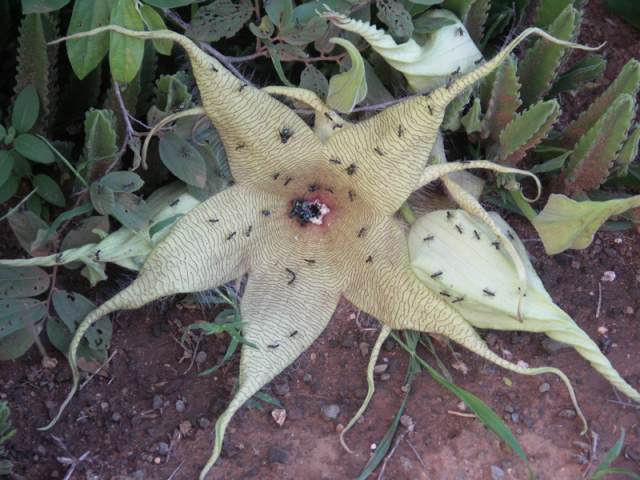
Stapelia gigantea is a very variable species with the largest flowers in the genus ranging from 100-400 mm in diameter. It is the most widely north-south distributed species and occurs in Zambia, Malawi, Mozambique, Botswana, Zimbabwe and South Africa. It grows in many habitats and may form clumps of 1-2 m in diameter.
See more info below

Stapelia grandiflora is probably one of the best recorded of all S. African stapeliads. It is widely but scantly distributed over the Great Karoo, Free State and southwards to Port Elizabeth, but occurs mainly in the Eastern Cape. This is one of the species with the most robust stems and may reach a height of 300 mm, with compressed angles and prominent teeth. Flower buds are typically rounded where the segments meet; the flowers are up to 150 mm in diameter, dark purple-brown, usually darker towards the tips of the segments, with long purple hairs on the disc. The lower part of the lobes is ciliate with long, simple, white hairs. It is distinguished from S. gigantea on account of distribution and the shape of the bud. It is also closely allied to S. hirsuta.
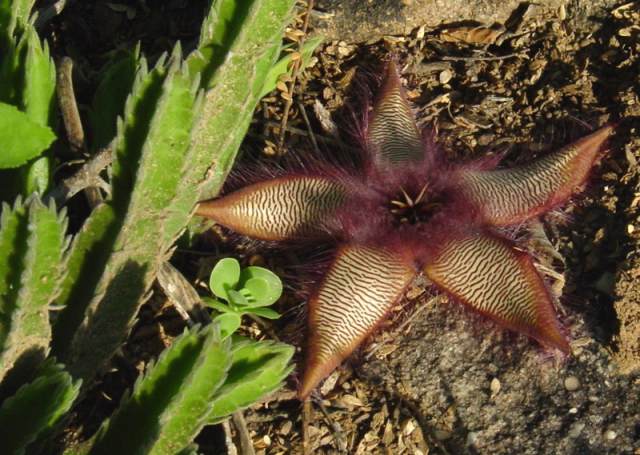
Stapelia gettliffei is native to the warmer, dry, sandy parts of the Limpopo River catchments in southeastern Botswana, the northern parts of South Africa, southern Zimbabwe, and just over the border into Mozambique to the east. It usually grows in low-lying areas in shaded situations, often with other stapelias of the same localities.
See more info below

Stapelia gettliffei plants usually sprawl in the shade of bushes and in the open are more erect and tightly knit. Tubercles are tipped with long, narrow leaf rudiments, the largest in the genus. The stems turn red in the dry season and become paper-thin. The flowers have long pedicels facing upwards, with the corolla marked in purple lines on a cream-coloured background, and the margins and central section have hairs. Flowering occurs from December-May. The specific epithet honours George Frederick Rawson Gettliffe (1873-1948), who collected extensively in remote areas of the northern parts of South Africa. The Venda name for the species is mahushule.

Stapelia kwebensis is the most widely distributed in an east-west direction, from Kaokoveld (northern Namibia, southern Angola ) through the Kalahari in Botswana, eastwards in the northernmost parts of South Africa, and in Zimbabwe. Plants usually grow in flat, rocky areas, in the open or below bushes. The stems are bright green, short-toothed with erect, prominent rudimentary leaves. Natural hybrids appear infrequently. Flowers are small, carried on short pedicels near the apex or in the middle of the stem and vary in coloration from yellow-ish to green to brown or dark red. Plants produce their evil-smelling flowers from December to May. The stems are slender and pale green, with the area between the ribs darker. The first plants were discovered on the Kwebe Hills (south of Lake Ngami ) in northern Botswana, hence the specific epithet. It is difficult to cultivate under humid and wet summer rainfall conditions.
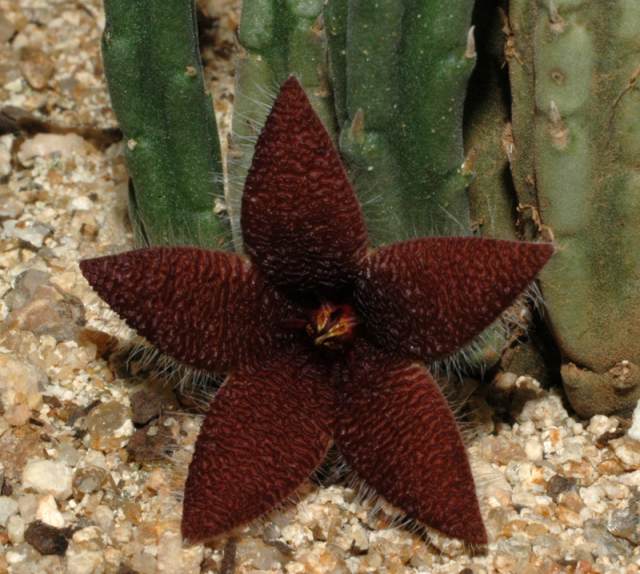
Stapelia olivacea is a South African endemic and grows amongst stones and boulders in mountainous areas of the Great Karoo (north-central Karoo and southwestern Free State). Despite its wide range, it is locally very rare and does not appear to be common anywhere today.
See more info below .

Stapelia olivacea flowers are small, almost flat, with white hairs along the margins. The colour is very variable. Apparently darker maroon-red flowers usually emit a strong, offensive odour of excrement, but the greenish flowers have a mushroom-like smell that is more pleasant. The stems are greyish along the flanks, with the grooves in between a darker green, sometimes purplish. The stems form attractive, neat clumps about 100 mm high. The epithet refers to the olive-green colour used in the first painting of this species.
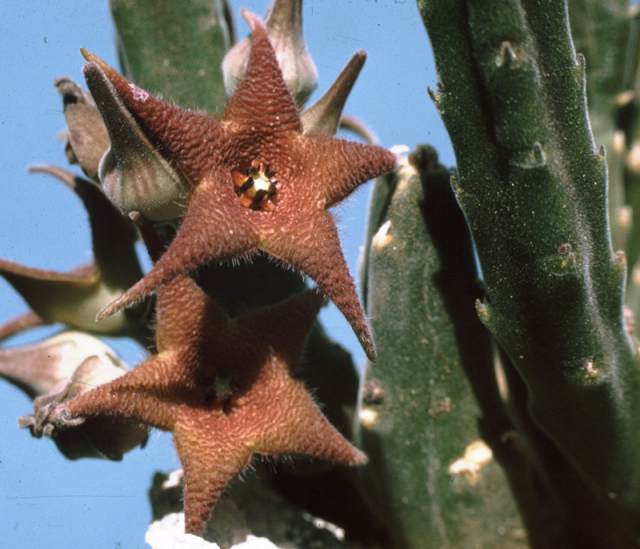
Stapelia rufa is endemic to South Africa, with populations widely scattered between Upington, Oudtshoorn, Montagu and Ladismith. It usually grows on stony, north-facing slopes, and like many stapeliads, in the protection of bushes. Plants bear small flowers, usually towards the base. The flowers are reddish to brown, the segments of the corolla narrowing into long slender points. The stems are 4-angled but somewhat round in cross section and without grooves between the flanks of the stem. This species flowers in spring.
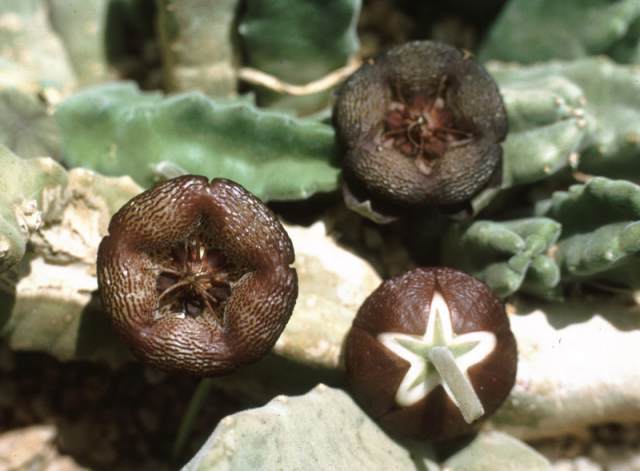
Stapelia engleriana is a South African endemic, widely distributed in the drier areas of the southwestern Karoo between Laingsburg, Beaufort West and Prince Albert. If these stapelias are sheltered by other plants, they can become up to 300 mm tall. The characteristic thick, square, prostrate to rhizomatous stems are easily identifiable. The lobes of the flowers are folded back completely, giving the flowers a round, button-shaped appearance. The flowers are purple-brown to red-maroon, about 25 mm in diameter and sometimes last for more than a week. It is generally a less attractive plant with an untidy habit due to new growth starting from points where the stem has been damaged or broken.
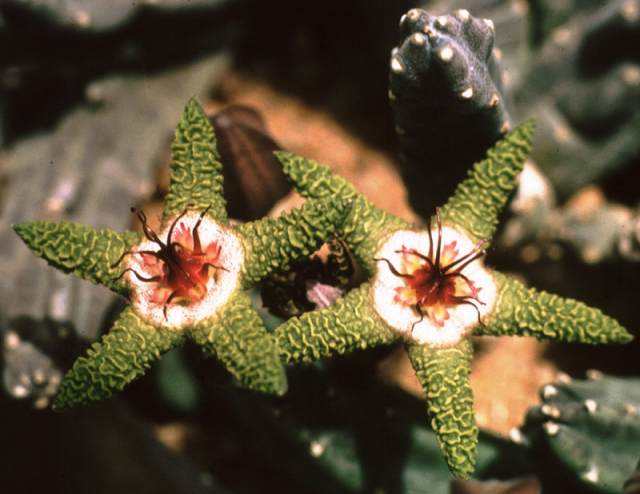
Stapelia flavopurpurea is not a common species but is widely distributed in both Namibia and South Africa (western Karoo to the Northern Cape). Plants grow amongst stones at the base of other shrubs. The short, uniformly green stems are 4-angled and up to 100 mm tall. The star-like flowers of this striking species are deeply lobed and the margins are folded backwards, with a central disc covered in short, clavate, purple to white hairs. Flowers are borne (sometimes in clusters) near the tips of the stems and have been reported to be pleasantly scented. It superficially resembles the flowers of Tridentea virescens, the only other stapeliad that exhibits such extravagant and exotic coloration. The flowers are usually bright yellow, but various shades from yellow, green, red to brown have been reported. Although the flowers are smaller than those of most other species in the genus, they are very beautiful and lack the unpleasant smell so characteristic of most members of this genus.

Stapelia unicornis is confined to the southern parts of the Lebombo Mountains in South Africa (Mpumalanga and KwaZulu-Natal), Mozambique and Swaziland. Plants grow on shallow soils, ledges and rocky outcrops. The pale green stems form stout clumps, rarely higher than 100 mm. The flowers are pale green-pinkish and about 100 mm in diameter. The centre of the flower is almost bowl-shaped. A species closely related to S. gigantea, but with smaller flowers that are decisively bowl-shaped and with different inner corona lobes. Plants are relatively easily cultivated.

Stapelia leendertziae is most conspicuous when in flower owing to the unique large, bell-shaped, deep reddish to dark purple flowers that are up to 120 mm long. It is widely grown in gardens but distinctly uncommon in the wild. It occurs on the mountains of the northeastern escarpment and Swaziland where it seems to be confined to rocky ground with shallow soils.
See more info below.
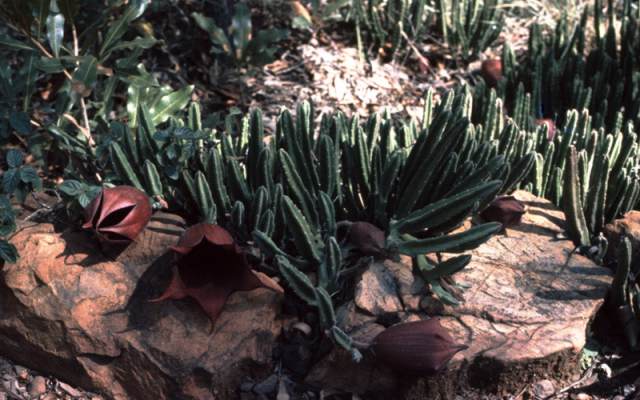
Stapelia leendertziae stems are darker and dull green compared to those of S. gigantea and S. unicornis. Flowers are produced at the base or in the lower half from new branches. This species was named after Miss Reino Leendertz, the first official botanist employed at the Transvaal Museum and who was the first to collect this species near Heidelberg in 1909. Flowering time is November-January. It is readily cultivated and can withstand a fair degree of frost. Known as aaskelk, aasklok or rooiaasblom (Afr.).
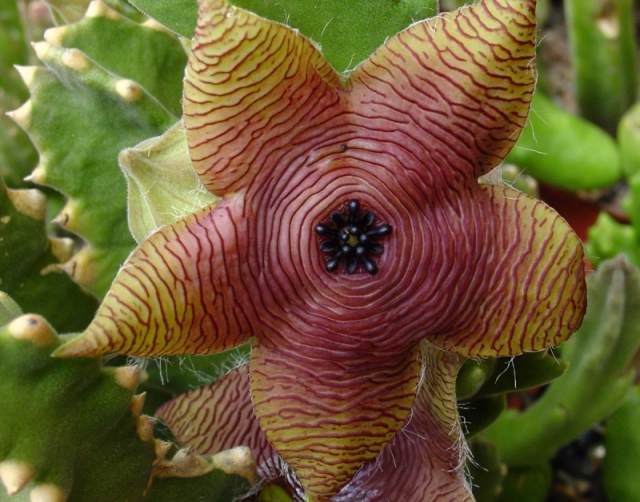
Stapelia clavicorona is an endemic restricted to the northern slopes of the Soutpansberg in the Limpopo Province of South Africa. Plants grow on hot, stony slopes and consist of a few, robust stems (by far the most robust stems in the genus) that are deeply indented between the angles. Stems are olive-green and turn reddish in the dry season. Older stems become corky and white. Flowers are relatively small (50 mm in diameter). The pale pinkish green flowers are textured with club-shaped hairs along the margins of the corolla. Propagation from cuttings and seed is relatively easy. Plants flower from October-December. It was first collected in 1931 and the specific epithet refers to the club-shaped (clavate) corona lobes.
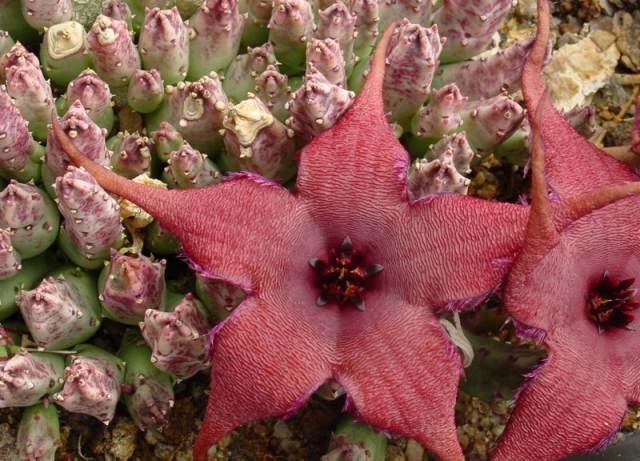
Stapelia schinzii is found in Namibia and southern Angola. Three varieties are recognised, the typical one only occurring in Namibia. The plants are large and robust, and sometimes spread for up to 1 m, stems arising from a short horizontal base. The stems are mostly purple-mottled and up to 60 mm tall. Compared to the stems, the dark red to maroon flowers are relatively large (up to 120 mm in diameter). They have elongate corolla lobes, fringed with vibratile, purple, club-shaped hairs. This is the species with the largest flowers in Namibia and is closely related to the threatened S. pillansii.
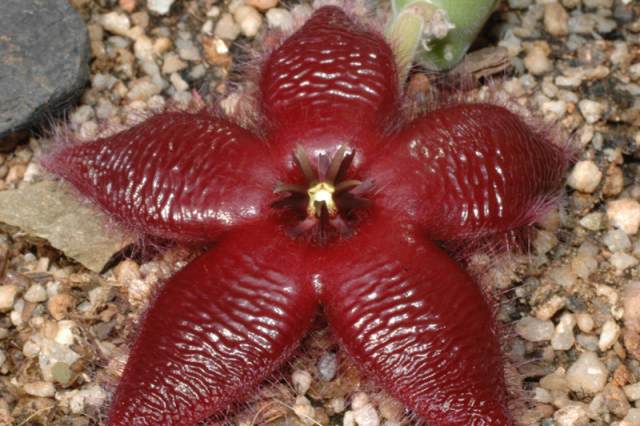
Stapelia hirsuta is widely distributed and extremely variable, with five varieties recognised by Bruyns (2005). It is found in Namaqualand and the Eastern Cape ( South Africa ) and in southern Namibia, seemingly restricted to the mainly winter rainfall areas. It is closely related to S. grandiflora. The stems are up to 200 mm high, with flowers 100-200 mm across. The flowers are cream-coloured, purple at the centre, with purplish transverse lines on the lobes which have purple-brown tips. The corona, flower size, proportions of the corolla, density and texture of hairs, and details of patterning and colour, all vary within wide limits. This was the second species to be discovered and is locally known as haasoor (Afr.).
Plant Attributes:
Plant Type:
SA Distribution:
Soil type:
Flowering season:
PH:
Flower colour:
Aspect:
Gardening skill:
Special Features:
Horticultural zones






Rate this article
Article well written and informative
Rate this plant
Is this an interesting plant?
Login to add your Comment
Back to topNot registered yet? Click here to register.